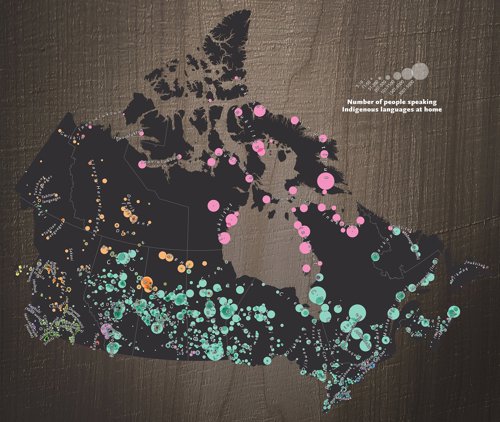(Note: Pending review and approval by the UArctic Indigenous Advisory Board.)
Around 65-90+ Aboriginal languages are/were used on the land now known as Canada, spread across 12 distinct language families and spoken by the First Nations, Métis, and Inuit Peoples. A 2016 census found that around 70 languages were being spoken by 260,500+ people, with the Algonquian language family being the most spoken. This linguistic richness is reflected in the offerings of higher education systems, as around 20 languages are represented across 13 of UArctic’s Canadian members alone.
A part of Canadian history that must not be forgotten and which relates directly to the current state of Indigenous languages in Canada is the residential school system. Tens of thousands of Indigenous children were sent to these schools to assimilate them into Euro-Canadian society, and this continued into the latter half of the 1990s. Thousands of students suffered severe abuse and died at these schools, and many survivors carry trauma from their experiences. This has had significant negative effects on Indigenous communities and families, from disruptions of inter-generational culture and language transfer to individuals left with physical and mental health problems.
Today, there is much effort across the country devoted to revitalizing and preserving Indigenous languages, and some programs at the higher education level for instance are quite comprehensive in the educational opportunities they offer.

University of Northern British Columbia
University of Northern British Columbia
University of Prince Edward Island
University of Northern British Columbia
Wilp Wilxo'oskwhl Nisga'a Institute
University of Northern British Columbia
University of Northern British Columbia
Jimerson, J. R. (2021). Ionkwahronkha’onhátie’: Child Perspectives on Adult Second Language Learning within Mohawk Communities. Multiethnica, 41, 68–87. (PDF)
Miyashita, M., & Chatsis, A. (2015). Respecting Dialectal Variations in a Blackfoot Language Class 1. (PDF)
Oxford, W. (2019). Indigenous Languages in Canada (E. Gold, Ed.). Robarts Centre for Canadian Studies, York University, Toronto, Canada. (PDF)
Windsor, Matthew. (2024). Rhythm and Intonation in Oji-Cree. DOI: 10.14321/jj.9345418.20. (PDF)